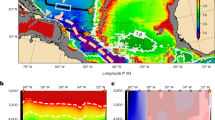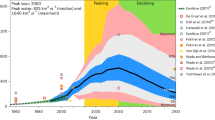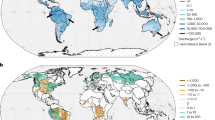Abstract
Knowing the extent of human influence on the global hydrological cycle is essential for the sustainability of freshwater resources on Earth1,2. However, a lack of water level observations for the world’s ponds, lakes and reservoirs has limited the quantification of human-managed (reservoir) changes in surface water storage compared to its natural variability3. The global storage variability in surface water bodies and the extent to which it is altered by humans therefore remain unknown. Here we show that 61% per cent of the Earth’s seasonal surface water storage variability occurs in human-managed reservoirs. Using measurements from NASA’s ICESat-2 satellite laser altimeter, which was launched in late 2018, we assemble an extensive global water level dataset that quantifies water level variability for 227,386 water bodies from October 2018 to July 2020. We find that seasonal variability in human-managed reservoirs averages 0.86 metres, whereas natural water bodies vary by only 0.22 metres. Natural variability in surface water storage is greatest in tropical basins, whereas human-managed variability is greatest in the Middle East, southern Africa and the western USA. Strong regional patterns are also found, with human influence driving 67 per cent of surface water storage variability south of 45 degrees north and nearly 100 per cent in certain arid and semi-arid regions. As economic development, population growth and climate change continue to pressure global water resources4, our approach provides a useful baseline from which ICESat-2 and future satellite missions will be able to track human modifications to the global hydrologic cycle.
This is a preview of subscription content, access via your institution
Access options
Access Nature and 54 other Nature Portfolio journals
Get Nature+, our best-value online-access subscription
$29.99 / 30 days
cancel any time
Subscribe to this journal
Receive 51 print issues and online access
$199.00 per year
only $3.90 per issue
Buy this article
- Purchase on Springer Link
- Instant access to full article PDF
Prices may be subject to local taxes which are calculated during checkout




Similar content being viewed by others
Data availability
ICESat-2 data are available from the National Snow and Ice Data Center (NSIDC) at https://nsidc.org/data/atl08. The Global Surface Water Occurrence dataset can be downloaded from https://global-surface-water.appspot.com/. The Global Reservoirs and Dams database (GRanD) can be downloaded from Global Dam Watch at http://globaldamwatch.org/grand/ and the GlObal GeOreferenced Database of Dams (GOODD) can be downloaded from Global Dam Watch at http://globaldamwatch.org/goodd/. USGS gauge data can be downloaded from https://waterdata.usgs.gov/nwis/rt, California Department of Water Resources data can be downloaded from https://cdec.water.ca.gov/, and G-REALM data can be accessed at https://ipad.fas.usda.gov/cropexplorer/global_reservoir/. The water-body masks derived from GSWO, water levels derived from ICESat-2 and all validation analyses are available at https://doi.org/10.5281/zenodo.4489056.
Code availability
The scripts used to create the water-body masks, derive water levels from ICESat-2 and produce the figures are publicly available at https://github.com/sarahwcooley/icesat2-water-levels.
Change history
12 June 2023
A Correction to this paper has been published: https://doi.org/10.1038/s41586-023-06165-7
References
Gleick, P. H. Global freshwater resources: soft-path solutions for the 21st century. Science 302, 1524–1528 (2003).
Tranvik, L. J. et al. Lakes and reservoirs as regulators of carbon cycling and climate. Limnol. Oceanogr. 54, 2298–2314 (2009).
Alsdorf, D., Rodriguez, E. & Lettenmaier, D. P. Measuring surface water from space. Rev. Geophys. 45, RG2002 (2007).
Mekonnen, M. M. & Hoekstra, A. Y. Sustainability: four billion people facing severe water scarcity. Sci. Adv. 2, e1500323 (2016).
Chao, B. F., Wu, Y. H. & Li, Y. S. Impact of artificial reservoir water impoundment on global sea level. Science 320, 212–215 (2008).
Smith, L. C. Rivers of Power: How a Natural Force Raised Kingdoms, Destroyed Civilizations, and Shapes our World. (Little, Brown, Spark, 2020).
Zhao, G. & Gao, H. Estimating reservoir evaporation losses for the United States: fusing remote sensing and modeling approaches. Remote Sens. Environ. 226, 109–124 (2019).
Deemer, B. R. et al. Greenhouse gas emissions from reservoir water surfaces: a new global synthesis. BioScience 66, 949–964 (2016).
Cushman, R. M. Review of ecological effects of rapidly varying flows downstream from hydroelectric facilities. N. Am. J. Fish. Manage. 5, 330–339 (1985).
Pelicice, F. M., Pompeu, P. S. & Agostinho, A. A. Large reservoirs as ecological barriers to downstream movements of Neotropical migratory fish. Fish Fish. 16, 697–715 (2015).
Gillespie, B. R., Desmet, S., Kay, P., Tillotson, M. R. & Brown, L. E. A critical analysis of regulated river ecosystem responses to managed environmental flows from reservoirs. Freshw. Biol. 60, 410–425 (2015).
Wang, J., Sheng, Y., Gleason, C. J. & Wada, Y. Downstream Yangtze River levels impacted by Three Gorges Dam. Environ. Res. Lett. 8, 044012 (2013).
Kondolf, G. M., Rubin, Z. K. & Minear, J. T. Dams on the Mekong: cumulative sediment starvation. Water Resour. Res. 50, 5158–5169 (2014).
Pekel, J.-F., Cottam, A., Gorelick, N. & Belward, A. S. High-resolution mapping of global surface water and its long-term changes. Nature 540, 418–422 (2016).
Shiklomanov, A. I., Lammers, R. B. & Vorosmarty, C. J. Widespread decline in hydrological monitoring threatens pan-Arctic research. Eos 83, 13–17 (2002).
Lawford, R., Strauch, A., Toll, D., Fekete, B. & Cripe, D. Earth observations for global water security. Curr. Opin. Environ. Sustain. 5, 633–643 (2013).
Gao, H., Birkett, C. & Lettenmaier, D. P. Global monitoring of large reservoir storage from satellite remote sensing. Water Resour. Res. 48, W09504 (2012).
Gao, H. Satellite remote sensing of large lakes and reservoirs: from elevation and area to storage. Wiley Interdiscip. Rev. Water 2, 147–157 (2015).
Zhou, T., Nijssen, B., Gao, H. & Lettenmaier, D. P. The contribution of reservoirs to global land surface water storage variations. J. Hydrometeorol. 17, 309–325 (2016).
Rodell, M., Famiglietti, J. S., Wiese, D. N., Reager, J. T. & Beaudoing, H. K. Emerging trends in global freshwater availability. Nature 557, 651–659 (2018); correction 565, E7 (2019).
Getirana, A., Kumar, S., Girotto, M. & Rodell, M. Rivers and floodplains as key component of global terrestrial water storage variability. Geophys. Res. Lett. 44, 10359–10368 (2017).
Lehner, B. et al. High-resolution mapping of the world’s reservoirs and dams for sustainable river-flow management. Front. Ecol. Environ. 9, 494–502 (2011).
Mulligan, M., van Soesbergen, A. & Sáenz, L. GOODD, a global dataset of more than 38,000 georeferenced dams. Sci. Data 7, 31 (2020).
Lehner, B. & Döll, P. Development and validation of a global database of lakes, reservoirs and wetlands. J. Hydrol. 296, 1–22 (2004).
Smith, L. C., Sheng, Y. & MacDonald, G. M. A first pan-Arctic assessment of the influence of glaciation, permafrost, topography and peatlands on Northern Hemisphere lake distribution. Permafr. Periglac. Process. 18, 201–208 (2007).
Ryan, J. C., Smith, L. C., Cooley, S. W., Pitcher, L. H. & Pavelsky, T. M. Global characterization of inland water reservoirs using ICESat‐2 altimetry and climate reanalysis. Geophys. Res. Lett. 47, 1–10 (2020).
Markus, T. et al. The Ice, Cloud, and Land Elevation Satellite-2 (ICESat-2): science requirements, concept, and implementation. Remote Sens. Environ. 190, 260–273 (2017).
Biancamaria, S., Lettenmaier, D. P. & Pavelsky, T. M. The SWOT mission and its capabilities for land hydrology. Surv. Geophys. 37, 307–337 (2016).
Marzeion, B., Cogley, J. G., Richter, K. & Parkes, D. Attribution of global glacier mass loss to anthropogenic and natural causes. Science 345, 919–921 (2014).
Zemp, M. et al. Global glacier mass changes and their contributions to sea-level rise from 1961 to 2016. Nature 568, 382–386 (2019); correction 577, E9 (2020).
Hansen, M. C. et al. High-resolution global maps of 21st-century forest cover change. Science 342, 850–853 (2013).
Taubert, F. et al. Global patterns of tropical forest fragmentation. Nature 554, 519–522 (2018).
Nienhuis, J. H. et al. Global-scale human impact on delta morphology has led to net land area gain. Nature 577, 514–518 (2020).
Syvitski, J. P. M., Vorosmarty, C. J., Kettner, A. J. & Green, P. Impact of humans on the flux of terrestrial sediment to the global coastal ocean. Science 308, 376–380 (2005).
Rodell, M., Velicogna, I. & Famiglietti, J. S. Satellite-based estimates of groundwater depletion in India. Nature 460, 999–1002 (2009).
Famiglietti, J. S. The global groundwater crisis. Nat. Clim. Change 4, 945–948 (2014).
Grill, G. et al. Mapping the world’s free-flowing rivers. Nature 569, 215–221 (2019); correction 572, E9 (2019).
Neumann, T. A. et al. The Ice, Cloud, and Land Elevation Satellite – 2 mission: a global geolocated photon product derived from the Advanced Topographic Laser Altimeter System. Remote Sens. Environ. 233, 111325 (2019).
Neuenschwander, A. L. et al. ATLAS/ICESat-2 L3A Land and Vegetation Height, Version 3 (NASA National Snow and Ice Data Center Distributed Active Archive Center, accessed 20 October 2020); https://nsidc.org/data/ATL08/versions/3
Neuenschwander, A. & Pitts, K. The ATL08 land and vegetation product for the ICESat-2 mission. Remote Sens. Environ. 221, 247–259 (2019).
Neuenschwander, A. L. & Pitts, K. Algorithm Theoretical Basis Document (ATBD) for Land-Vegetation Along-Track Products (ATL08) Release 002 https://icesat-2.gsfc.nasa.gov/sites/default/files/page_files/ICESat2_ATL08_ATBD_r002_v2.pdf (2019).
Yamazaki, D. et al. MERIT Hydro: a high-resolution global hydrography map based on latest topography dataset. Water Resour. Res. 55, 5053–5073 (2019).
Birkett, C. M. et al. G-REALM: A lake/reservoir monitoring tool for water resources and regional security assessment. In American Geophysical Union Fall Meeting https://agu.confex.com/agu/fm18/meetingapp.cgi/Paper/374138 (2018).
Lehner, B. & Grill, G. Global river hydrography and network routing: baseline data and new approaches to study the world’s large river systems. Hydrol. Processes 27, 2171–2186 (2013).
Global Runoff Data Center. Major River Basins of the World (Federal Institute of Hydrology, accessed 15 May 2020); https://www.bafg.de/GRDC/EN/02_srvcs/22_gslrs/221_MRB/riverbasins_node.html
Parrish, C. E. et al. Validation of ICESat-2 ATLAS bathymetry and analysis of ATLAS’s bathymetric mapping performance. Remote Sens. 11, 1634 (2019).
Acknowledgements
This research was funded by the NASA Studies with ICESat-2 programme (grant #80NSSC20K0963) managed by T. Markus, and the NASA Surface Water and Ocean Topography mission (grant #80NSSC20K1144S) managed by N. Vinogradova-Shiffer. S.W.C. gratefully acknowledges support from an NSF Graduate Research Fellowship and the Stanford Science Fellows programme. J.C.R. is grateful for support from a Voss Postdoctoral Fellowship through the Institute at Brown for Environment and Society. We thank M. Mulligan at King’s College London for making the GOODD dataset publicly available at Global Dam Watch.
Author information
Authors and Affiliations
Contributions
S.W.C. and J.C.R. conceived the project. S.W.C. developed the methodology, carried out the data analysis, interpreted results and wrote the manuscript. J.C.R. and L.C.S. interpreted results and co-wrote the manuscript.
Corresponding author
Ethics declarations
Competing interests
The authors declare no competing interests.
Additional information
Peer review information Nature thanks Lori Magruder, Kuo-Hsin Tseng and the other, anonymous, reviewer(s) for their contribution to the peer review of this work. Peer reviewer reports are available.
Publisher’s note Springer Nature remains neutral with regard to jurisdictional claims in published maps and institutional affiliations.
Extended data figures and tables
Extended Data Fig. 1 Number of ICESat-2 observations received by each water body over the 22-month (October 2018 to July 2020) study period.
a, Histogram of the number of observations. b, Number of observations by lake area (in km2). Note that observations are aggregated to monthly time steps and therefore the actual number of ICESat-2 observations is slightly higher. In b, the x axis is plotted on a log scale. In total, 43% of lakes receive two observations, 24% receive three observations, and 32% receive four or more observations. There is a strong positive correlation with lake area, as shown in b. For example, although the average across all water bodies is 3.3 observations over the 22-month period, lakes larger than 10 km2 average 7.3 observations.
Extended Data Fig. 2 Monthly time series of water levels as observed by ICESat-2 (orange) and G-REALM (blue).
a–e, The x axis spans the ICESat-2 record (October 2018 to July 2020) and the y axis shows the normalized elevation (elevation − mean elevation over this period), which is required owing to differences in the vertical datum between the two datasets. From top to bottom the lakes are: a, La Grande Rivière Reservoir in Canada (53.788, −74.822): area = 4,054 km2, ICESat-2 range = 5.33 m, G-REALM range = 5.21 m. b, Lago Argentino in Argentina (−50.257, −72.711): area = 2,540 km2, ICESat-2 range = 2.63 m, G-REALM range = 2.51 m. c, Lake Tana in Ethiopia (12.001, 37.336): area = 3,580 km2, ICESat-2 range = 1.99 m, G-REALM range = 1.99 m. d, Lake Chad in central-west Africa (13.094, 14.480): area = 1,358 km2, ICESat-2 range = 1.52 m, G-REALM range = 1.59 m. e, Lake Bankim in Cameroon (6.160, 11.382): area = 137 km2, ICESat-2 range = 7.57 m, G-REALM range = 7.74 m.
Extended Data Fig. 3 Comparison between ATL03 (global geolocated photon data) and ATL08 (land and vegetation height product).
The y axis shows the elevation in m, and the x axis (along-track distance) refers to the distance (in m) from the start of the ICESat-2 track. The lakes shown are: a, Antelope Lake, California, USA (40.179, −120.595). b, Crater Lake, Oregon, USA (42.939, −122.109). c, Fern Ridge Lake, Oregon, USA (44.096, −123.301). d, Trinity Lake, California, USA (40.961, −122.681).
Extended Data Fig. 4 Evaluation of ICESat-2 height retrievals against in situ gauge measurements.
Each point represents a temporal change in height between two dates from both ICESat-2 and gauge measurements. a, b, Plots of ICESat-2 height difference against the corresponding gauge height difference; b shows a magnified version (ranging from −1 to 1 m) of a. c, Histogram of the difference between ICESat-2 and USGS gauge measurements. Overall, we find very good agreement between ICESat-2 and gauge measurements, with an MAE of 0.14 m and a mean bias of −0.019 m.
Extended Data Fig. 5 Evaluation of ICESat-2 range in water level against in situ gauge measurements.
Here, each point represents a single water body. a, The total range in water level (that is, maximum minus minimum) observed by gauges and ICESat-2 over the 22-month ICESat-2 record, October 2018 to July 2020. On average, we find that ICESat-2 observes 49% of the variability observed by gauges (as indicated by the dashed line). b, The mean annual range in water level over 2010–2020 (by water year) versus our observed ICESat-2 range. Here we find that, on average, ICESat-2 observes 58% (dashed line) of the 10-year mean variability.
Extended Data Fig. 6 Evaluation of ICESat-2 observed storage change versus California Department of Water Resources storage change estimates.
a, For pairs of dates with both ICESat-2 observations and CDWR storage estimates for the same lake, we calculate the difference in storage observed by ICESat-2 by multiplying the height change by our lake area estimate from the water-body mask and compare this to the CDWR storage change between these two dates. b, A histogram of the difference between our ICESat-2-derived and CDWR storage estimates. Overall, we find that ICESat-2 slightly underestimates storage variability relative to CDWR storage observations thanks to our use of a conservative water mask, though, importantly, this underestimation is consistent across all water bodies.
Supplementary information
Rights and permissions
Springer Nature or its licensor (e.g. a society or other partner) holds exclusive rights to this article under a publishing agreement with the author(s) or other rightsholder(s); author self-archiving of the accepted manuscript version of this article is solely governed by the terms of such publishing agreement and applicable law.
About this article
Cite this article
Cooley, S.W., Ryan, J.C. & Smith, L.C. Human alteration of global surface water storage variability. Nature 591, 78–81 (2021). https://doi.org/10.1038/s41586-021-03262-3
Received:
Accepted:
Published:
Issue Date:
DOI: https://doi.org/10.1038/s41586-021-03262-3
This article is cited by
-
Spatiotemporal lake area changes influenced by climate change over 40 years in the Korean Peninsula
Scientific Reports (2024)
-
Monitoring Earth’s climate variables with satellite laser altimetry
Nature Reviews Earth & Environment (2024)
-
Water Level Fluctuations Modulate the Microbiomes Involved in Biogeochemical Cycling in Floodplains
Microbial Ecology (2024)
-
Hydrological processes and water quality in arid regions of Central Asia: insights from stable isotopes and hydrochemistry of precipitation, river water, and groundwater
Hydrogeology Journal (2024)
-
Inundation dynamics of the natural and manmade wetlands in the Mayurakshi River basin, Eastern India
Environmental Science and Pollution Research (2024)
Comments
By submitting a comment you agree to abide by our Terms and Community Guidelines. If you find something abusive or that does not comply with our terms or guidelines please flag it as inappropriate.



